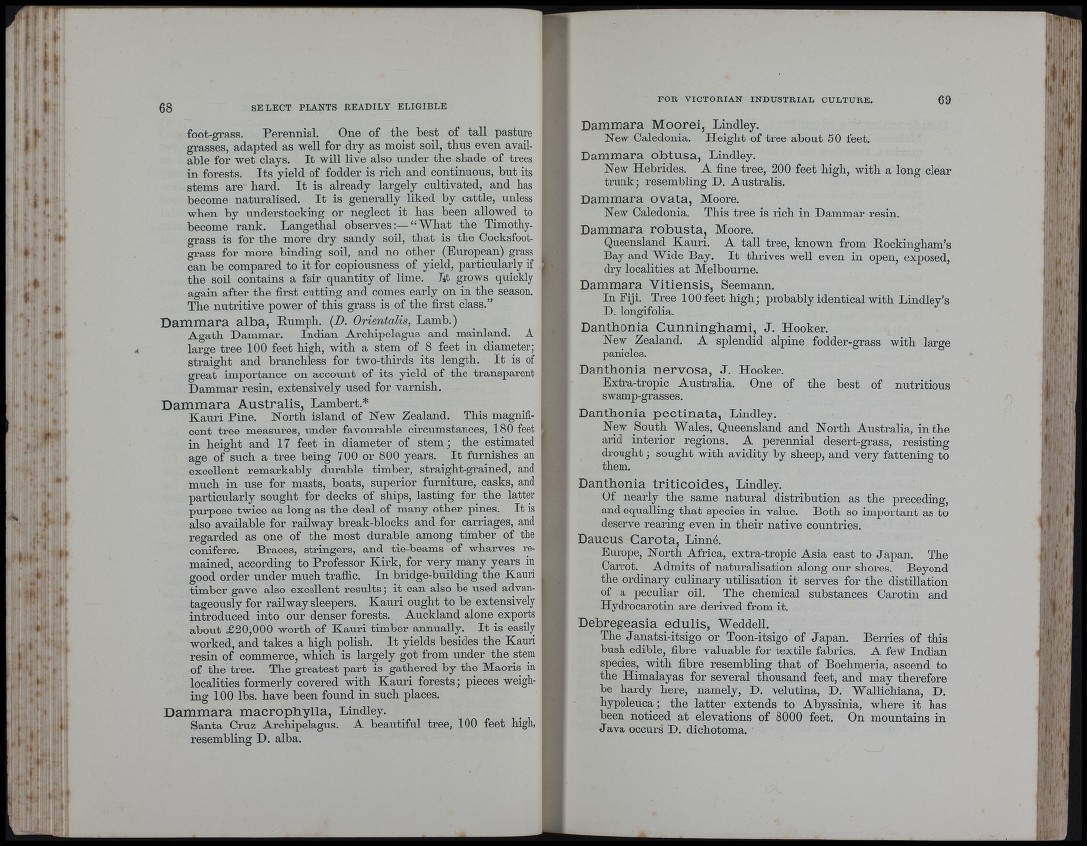
r
■ :|l'
■ »t(
111 '
1
foot-grass. Perennial. One of the best of tall pasture
grasses, adapted as well for dry as moist soil, tbus even available
for wet clays. I t will live also under the shade of trees
in forests. Its yield of fodder is rich and continnons, bnt its
stems are hard. I t is already largely cultivated, and has
become naturalised. I t is generally liked by cattle, unless
when by understocking or neglect it has been allowed to
become rank. Langethal observes;—“What the Timothy-
grass is for the more dry sandy soil, that is the Cocksfoot-
grass for more binding soil, and no other (European) grass
can be compared to it for copiousness of yield, particularly if
tbe soil contains a fair quantity of lime. Jit grows quickly
again after the first cutting and comes early on in tbe season.
The nutritive power of this grass is of the first class.”
Dammara alba, Eumpli. {D. Orientalis, Lamb.)
Agath Dammar. Indian Archipelagus and mainland. A
large tree 100 feet high, with a stem of 8 feet in diameter;
straight and branchless for two-thirds its length. I t is of
great importance on account of its yield of the transparent
Dammar resin, extensively used for varnish.
Dammara Australis, Lambert.*
Kauri Pine. North island of New Zealand. This magnificent
tree measures, under favourable circumstances, 180 feet
in height and 17 feet in diameter of stem; the estimated
age of such a tree being 700 or 800 years. I t furnishes an
excellent remarkably durable timber, straight-grained, and
much in use for masts, boats, superior furniture, casks, and
particularly sought for decks of ships, lasting for the latter
purpose twice as long as the deal of many other pines. I t is
also available for railway break-blocks and for carriages, and
regarded as one of the most durable among timber of the
coniferse. Braces, stringers, and tie-beams of wharves remained,
according to Professor Kirk, for very many years in
good order under much traffic. In bridge-building the Kauri
timber gave also excellent results; it can also be used advantageously
for railway sleepers. Kauri ought to be extensively
introduced into our denser forests. Auckland alone exports
about £20,000 worth of Kauri timber annually. I t is easily
worked, and takes a high polish. I t yields besides the Kauri
resin of commerce, which is largely got from under the stem
of the tree. The greatest part is gathered by the Maoris in
localities formerly covered with Kauri forests; pieces weighing
100 lbs. have been found in such places.
Dammara macrophylla, Lindley.
Santa Cruz Archipelagus. A beautiful tree, 100 feet high,
resembling D. alba.
FOR VICTORIAN INDUSTRIAL CULTURE. 69
Dammara Moorei, Lindley.
New Caledonia. Height of tree about 50 feet.
Dammara obtusa, Lindley.
New Hebrides. A fine tree, 200 feet high, with a long clear
trunk; resembling D. Australis.
Dammara ovata, Moore.
New Caledonia. This tree is rich in Dammar resin.
Dammara robusta, Moore.
Queensland Kauri. A tall tree, known from Bockingham’s
Bay and Wide Bay. I t thrives well even in open, exposed,
dry localities at Melbourne.
Dammara Vitiensis, Seemami.
In Fiji. Tree 100 feet high; probably identical with Findley’s
D. longifolia.
Danthonia Cunninghami, J. Hooker.
New Zealand. A splendid alpine fodder-grass with large
panicles.
Danthonia nervosa, J . Hooker.
Extra-tropic Australia. One of the best of nutritious
swamp-grasses.
Danthonia pectinata, Lindley.
New South Wales, Queensland and North Australia, in tbe
arid interior regions. A perennial desert-grass, resisting
drought ; sought with avidity by sheep, and very fattening to
them.
Danthonia triticoides, Lindley.
Of nearly the same natural distribution as the preceding,
and equalling that species in value. Both so important as to
deserve rearing even in their native countries.
Daucus Carota, Linné.
Europe, North Africa, extra-tropic Asia east to Japan. The
Carrot. Admits of naturalisation along our shores. Beyond
the ordinary culinary utilisation it serves for the distillation
of a peculiar oil. The chemical substances Carotin and
Hydrocarotin are derived from it.
Debregeasia edulis, Weddell.
The Janatsi-itsigo or Toon-itsigo of Japan. Berries of this
hush edible, fibre valuable for textile fabrics. A few Indian
species, with fibre resembling th a t of Boehmeria, ascend to
the Himalayas for several thousand feet, and may therefore
he hardy here, namely, D. velutina, D. Wallichiana, D.
hypoleuca; the latter extends to Abyssinia, where it has
been noticed at elevations of 8000 feet. On mountains in
Java occurs D. dicbotoma.
1,.
i./ H
'j.
i ■
I : ■ )
’•I’ ;
: I v
! I